List of hillforts and ancient settlements in Somerset
Somerset is a ceremonial county in South West England. It is a rural county of rolling hills, such as the Mendip Hills, Quantock Hills and Exmoor National Park, and large flat expanses of land including the Somerset Levels. Modern man came to what is now known as Somerset during the Early Upper Palaeolithic era. In the Neolithic era, from about 3500 BC, there is evidence of farming when people started to manage animals and grow crops on farms cleared from the woodland, rather than act purely as hunter gatherers.[1][2] It is also likely that extraction and smelting of mineral ores to make tools, weapons, containers and ornaments in bronze and then iron started in the late Neolithic and into the Bronze and Iron Ages.[3]

The construction of Hill forts began in Britain in the Late Bronze and Early Iron Age, roughly the start of the first millennium BC.[4] The reason for their emergence, and their purpose, has been a subject of debate. It has been argued that they could have been military sites constructed in response to invasion from continental Europe, sites built by invaders, or a military reaction to social tensions caused by an increasing population and consequent pressure on agriculture. The dominant view since the 1960s has been that the increasing use of iron led to social changes in Britain. Deposits of iron ore were separated from the sources of tin and copper necessary to make bronze, and as a result trading patterns shifted and the old elites lost their economic and social status.[5] Archaeologist Barry Cunliffe believes that population increase played a role and has stated "the forts provided defensive possibilities for the community at those times when the stress of an increasing population burst out into open warfare. But I would not see them as having been built because there was a state of war. They would be functional as defensive strongholds when there were tensions and undoubtedly some of them were attacked and destroyed, but this was not the only, or even the most significant, factor in their construction".[6]
There are numerous Iron Age hill forts and ancient settlement sites in the county, some of which were later reused in the Dark Ages, such as Cadbury Castle,[7] Worlebury Camp[8] and Ham Hill. Other hill forts, such as Small Down Knoll, Solsbury Hill, Dolebury Warren and Burledge Hill, may have had a domestic purpose as well as a defensive role. The Iron Age tribes of the Somerset area were the Dobunni in north Somerset, Durotriges in south Somerset and Dumnonii in west Somerset.[9] Iron Age sites on the Quantock Hills, include major hill forts at Dowsborough and Ruborough, as well as smaller earthwork enclosures, such as Trendle Ring, Elworthy Barrows and Plainsfield Camp. In addition to the hill forts, several sites have been identified as settlements during the pre Roman period including Cambria Farm and the "Lake Villages" at Meare and Glastonbury which were built on a morass, on an artificial foundation of timber filled with brushwood, bracken, rubble and clay. Most of the sites fell out of use with the coming of the Romans and therefore this list covers those sites occupied until that time.
Almost all of the sites in the list are Scheduled Monuments. In the United Kingdom, a Scheduled Monument is a "nationally important" archaeological site or historic building, given protection against unauthorised change. Scheduled Monuments are specified in the Ancient Monuments and Archaeological Areas Act 1979, which defines a monument as:
- Any building, structure or work above or below the surface of the land, any cave or excavation; any site comprising the remains of any such building, structure or work or any cave or excavation; and any site comprising or comprising the remains of any vehicle, vessel or aircraft or other movable structure or part thereof... (Section 61 (7)).[10]
Damage to a scheduled monument is a criminal offence and any work taking place at one of these sites requires Scheduled Monument Consent from the Secretary of State. In England, the Department for Culture, Media and Sport keeps the register, or schedule, of nationally important sites which receive state protection, which now includes over 31,000 sites.[11]
Known hill forts and settlements
| Site name Alternative name(s) |
Age | National Heritage List for England number | Plan or photo | Location | Description |
|---|---|---|---|---|---|
| Athelney hill fort | Iron Age | 1019099[12] |  |
Athelney 51.0557°N 2.9331°W |
Athelney Hill fort is an Iron Age hill fort. It is in the area where Alfred the Great hid from the Danes after his defeat in 876 AD. The hill fort may also be the site where Alfred defeated the Danes two years later.[13] |
| Backwell hill fort | Iron Age | – | Backwell 51.4092°N 2.7289°W |
In 1933, Backwell Camp, an Iron Age hill fort, was discovered. Two of its three sides were protected by a ditch and a bank, with the outside of the bank on the edge of the cliffs upon which the fort was built. However, by 1956, quarrying had almost completely destroyed the site.[14][15] | |
| Banwell Camp | Stone Age Bronze Age Iron Age |
1008031[16] | – | Banwell 51.3270°N 2.8496°W |
Banwell Camp is a univallate Iron Age hill fort. Artefacts found in the campsite date back to the Bronze Age and Stone Age.[17] Some of the older banks in this site are still around 4 metres (13 ft) high.[18] |
| Bathampton Camp | Iron Age | 1002480[19] | 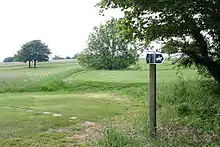 |
Bathampton 51.3847°N 2.3262°W |
The site of an early Iron Age stock enclosure which may also have been a fort. It was also used as a Roman field system. The site was excavated in the early 1900s and again in the 1950s. Artefacts from the site include human and animal remains, pottery, and flint flakes.[20] |
| Bat's Castle Caesar's Camp |
Iron Age | 1007667[21] |  |
Carhampton 51.1696°N 3.4495°W |
Bat's Castle is an Iron Age hill fort on the highest point of Gallox Hill.[22] Previously, it was known as "Caesar's Camp",[23] and it is possibly associated with Black Ball Camp. Bat's Castle has two stone ramparts and two ditches. The ramparts are damaged in places due to the number of visitors.[22][24] |
| Berry Castle Bury Camp |
Late Iron Age or early Romano-British | 1006204[25] | – | Luccombe 51.1924°N 3.6335°W |
Berry Castle is a hillside enclosure which survives as a series of earthworks. It dates from the late Iron Age or early Romano-British period.[26][27] |
| Black Ball Camp British Camp |
Iron Age | 1007668[28] |  |
Dunster 51.1740°N 3.4540°W |
Black Ball Camp is an Iron Age hill fort on the northern summit of Gallox Hill. It is also known as "British Camp" and is possibly associated with Bat's Castle.[29] It has a 3 metres (10 ft) high rampart and a 2 metres (7 ft) deep ditch. At the beginning of the 20th century, the foundations of a stone tower were visible.[30] |
| Blacker's Hill | Iron Age | 1015493[31] | – | Chilcompton 51.2493°N 2.5221°W |
This Iron Age promontory hill fort, Blacker's Hill, is roughly rectangular. It covers 6 hectares (15 acres) and originally had two ramparts and two ditches, but on the west and south sides, it was defended by the steep drop. In some places, the ramparts are still considerable, but on the north-eastern side, the inner rampart and ditch have been destroyed. There are three gaps, but only the one on the east seems to be original.[32][33] |
| Brean Down hill fort | Bronze Age | 1008211[34] | Brean 51.3230°N 3.0102°W |
Brean Down is a Bronze Age hill fort situated on a peninsula jutting out into the Bristol Channel. In ancient times, there were fields and barrows around the fort.[35] The site is now a National Trust site.[36] Roman coins have also been found here.[37][38] | |
| Brent Knoll Camp | Iron Age | 1008248[39] | 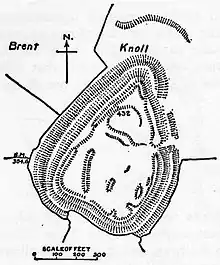 |
Brent Knoll 51.2543°N 2.9457°W |
The Brent Knoll Camp hill fort is a 1.6 hectares (16,000 m2) Iron Age hill fort that has been heavily damaged by cattle and quarrying. It is defended by a single wall around 10 metres (33 ft) high and by a single ditch, with an entrance on the eastern side. An urn containing coins of the Roman Emperors Trajan and Severus has been found at the site.[40][41] |
| Brewer's Castle | Iron Age | 1021358[42] | – | Dulverton 51.0563°N 3.5949°W |
Brewer's Castle, in Hawkridge Wood was an Iron Age defended settlement or hillfort.[43] It is very close to Mounsey Castle. |
| Broomfield Camp Higher Castles enclosure |
Late Prehistoric and/or Roman | – | – | Broomfield 51.0824°N 3.1199°W |
The univallate enclosure site at Broomfield dates from late prehistoric or Roman times. Archeological excavations in 1968 uncovered a trench through a bank and ditch which produced Iron Age pottery.[44][45] |
| Burgh Walls Camp | Iron Age | – | – | Long Ashton 51.4515°N 2.6278°W |
Burgh Walls Camp is a multivallate Iron Age hill fort on the banks above the River Avon, near where it is now crossed by the Clifton Suspension Bridge. It is also called "Bower Walls Camp", "Burwalls", or "Bowre Walls".[46] |
| Burledge hill fort | Iron Age | 1004526[47] |  |
Bishop Sutton 51.3232°N 2.6012°W |
Burledge hill fort is an univallate Iron Age hill fort situated on a promontory. The eastern side, the one with the most gradual slope, has an extra wall across it. Several pieces of clay found with iron slag indicate that the people who lived there may have smelted iron.[48] |
| Burrington Camp | Bronze Age Iron Age |
1011261[49] |  |
Burrington Combe 51.3214°N 2.7505°W |
Archaeological discoveries of early cemeteries show that humans occupied the combe and its caves from the Bronze Age with some evidence of occupation during the Upper Palaeolithic period.[50] There is also a sub-rectangular Iron Age univallate hill fort.[51] |
| Bury Castle | Iron Age | 1008808[52] |  |
Selworthy 51.2132°N 3.5511°W |
Bury Castle is a promontory fort that encloses an area of 0.2 hectares (0.49 acres). The main enclosure is encompassed by a single rampart and ditch, with steep drops on the north, east, and south sides. There is an additional rampart 30 metres (98 ft) to the west, with a deep ditch. The rampart is brevetted with drystone walling.[53][54] |
| Cadbury Camp | Iron Age Bronze Age Neolithic Period |
1008295[55] |  |
Tickenham 51.4485°N 2.7868°W |
Cadbury Camp is an Iron Age hill fort that encloses around 28,000 square metres (7 acres). The banks surrounding this site are around 3.0 metres (10 ft) to 3.7 metres (12 ft) above the neighbouring ditches. A Romano-British shrine, a Bronze Age spearhead, and Neolithic flake tools have been found inside the hill fort.[56] |
| Cadbury Castle Cadbury,[57] Camalet,[57] Cadenbyrig |
500 and 200 BC | 1011980[58] |  |
South Cadbury 51.0241°N 2.5318°W |
Cadbury Castle was fortified into a hill fort somewhere between 500 and 200 BC, and it encloses an area of 8 hectares (80,000 m2).[59] The site is associated with King Arthur's supposed court at Camelot.[60] |
| Cadbury Hill Cadbury-Congresbury |
Iron Age | 1011258[61] | – | Congresbury 51.3804°N 2.8032°W |
This hill fort is known, in archaeological circles, as Cadbury-Congresbury in order to differentiate it from the Cadbury Castle. It appears to have been constructed during the Iron Age, and the remains of Iron Age roundhouses may still be seen inside. The hill fort was refortified around 400 BC and occupation extended into the sub-Roman period, from which much imported pottery has been recovered. It has been suggested that this was the monastery of Saint Congar after whom Congresbury was named.[62][63] |
| Cambria Farm | Bronze Age | – | – | Ruishton 51.0160°N 3.0606°W |
Cambria Farm is the site of a burned Bronze Age mound and Iron Age roundhouses.[64][65] |
| Cannington Camp Cynwit Castle |
Bronze Age and Iron Age | 1006225[66] | 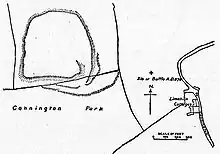 |
Cannington 51.1588°N 3.0796°W |
Cannington Camp is a univallate hill fort with walls that have been almost entirely destroyed. Archaeological artefacts such as stone scrapers, cores, and flakes have been found at the site.[67][68] |
| Castle Neroche hill fort | 1st millennium BC | 1008252[69] |  |
Staple Fitzpaine 50.9370°N 3.0374°W |
There are several bank-and-ditch earthworks near Castle Neroche, indicating the presence of a hill fort at some point during the 1st millennium BC.[70][71] |
| Castles Camp The Castles |
Iron Age | 1019150[72] | – | Bathealton 51.0117°N 3.3449°W |
Univallate hillfort with a slightly inturned entrance.[73][74] |
| Clatworthy Camp | Iron Age | 1006149[75] | – | Wiveliscombe 51.0743°N 3.3652°W |
Clatworthy Camp is an Iron Age hill fort situated on a promontory of the Brendon Hills above Clatworthy Reservoir. It is roughly triangular in shape with an area of 5.8 hectares (14 acres). It has a single bank and ditch, cut through solid rock. There may have been an entrance on the west and two on the east.[76][77] |
| Cleeve Toot Cleeve Hill hill fort |
Iron Age | 1011263[78] | 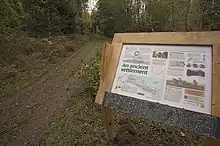 |
Cleeve 51.3878°N 2.7731°W |
Cleeve Toot, close to the village of Cleeve, is a roughly oval settlement which is approximately 125 metres (410 ft) in length by 90 metres (300 ft) in breadth. Approximately 150 metres (490 ft) to the north is another, smaller settlement.[15][79] |
| Conygar hill fort | Iron Age | 1007918[80] | – | Portbury 51.4732°N 2.7223°W |
Conygar hill fort is a small Iron Age univallate hill fort. The fort is triangular in shape and there are the remains of a three-foot high bank on the south-western side. There is a round barrow in the centre of the fort.[81] |
| Cow Castle | Iron Age | 1002955[82] |  |
Exford 51.1226°N 3.7253°W |
Cow Castle is an Iron Age hill fort occupying an isolated hilltop and has a single rampart and ditch, enclosing 0.9 hectares (2.2 acres). It is in the valley of the River Barle.[83][84] |
| Long Wood Enclosure | Iron Age | 1008255[85] | – | Dunster 51.1536°N 3.4580°W |
Univallate hillside enclosure, interior damaged by forestry plantation.[86][87][88] |
| Curdon Camp | Iron Age | 1006158[89] | – | Stogumber 51.1387°N 3.2850°W |
Curdon Camp has been almost completely destroyed by quarrying and bulldozing. A section remains that is still 2.5 metres (8.2 ft) high on the southern and western sides.[90][91] |
| Dinghurst fort | Iron Age | – | – | Churchill 51.3347°N 2.7982°W |
Dinghurst fort is the possible site of an Iron Age univallate hill fort.[92] Close to Dolebury Warren.[93] |
| Dolebury Warren Dolebury Camp |
Iron Age | 1008184[94] | 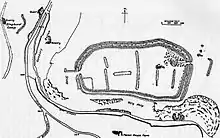 |
Churchill 51.3265°N 2.7907°W |
Dolebury Camp is a hill fort located on a ridge in the Mendip Hills 154 feet (47 m) above the surrounding area. The walls enclose an area of 9 hectares (22 acres), with the maximum height of 30 feet (9 m) on the northern side.[95][96] |
| Dowsborough Dowsborough Castle hill fort Dowsborough Camp or Danesborough or Dawesbury |
Iron Age | 1010494[97] |  |
Holford 51.1454°N 3.2015°W |
Dowsborough is an oval univallate hill fort. The surrounding bank is around 1 metre (3.3 ft) to 1.5 metres (4.9 ft) wide and around 1.2 metres (3.9 ft) high. There is a ditch outside the bank, and the distance from the bottom of the ditch to the top of the bank is around 2 metres (6.6 ft) to 3 metres (9.8 ft). Near the entrance to the hill fort are two structures that are probably gatehouses.[98] |
| Dundon Hill hill fort | Iron Age | 1014715[99] |  |
Compton Dundon 51.0868°N 2.7381°W |
Dundon Hill hill fort is an Iron Age hill fort guarded by a single bank ranging from .5 metres (1.6 ft) to 2.5 metres (8.2 ft) high. Flint flakes, Bronze Age pottery, and Iron Age pottery have also been found.[100][101] |
| Elborough Hill | Iron Age | – | – | Hutton 51.3202°N 2.9062°W |
Elborough Hill is the site of a bivallate hill fort, oval in shape, and defined by a triple bank on the northern side and a double out-turned bank on the southern side.[102] |
| Elworthy Barrows | Iron Age | 1020724[103] | 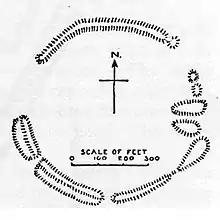 |
Brompton Ralph 51.0959°N 3.3295°W |
Elworthy Barrows is a heavily damaged circular hill fort which had never been finished. It was ploughed multiple times until around 1943, when artifacts were discovered.[104][105] |
| Glastonbury Lake Village | Iron Age | 1006156[106] |  |
Glastonbury 51.1633°N 2.7264°W |
Glastonbury Lake Village is an Iron Age lake village in Glastonbury. Each house was built on its own mound of clay in the lake, starting around 250 BC and continuing for at least 150 years. The entire settlement is surrounded by a pallisade made of timbers.[107][108] |
| Glastonbury Tor | Stone Age | 1019390[109] | 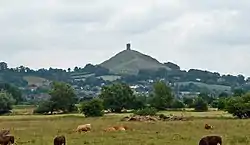 |
Glastonbury 51.1446°N 2.7004°W |
Paleolithic, Mesolithic, and Neolithic flint tools have been found at Glastonbury Tor,[110] which indicates that the site may have been occupied in the Stone Age. It is very close to the Glastonbury Lake Village, which was occupied in the Iron Age, starting around 250 BC.[107][111] |
| Grabbist hill fort | Iron Age | 1021060[112] | – | Dunster 51.1832°N 3.4565°W |
Oval shape measuring 886 feet (270 m) by 220 feet (67 m), surrounded by a bank and ditch.[113][114] |
| Ham Hill hill fort | Iron Age | 1003678[115] | 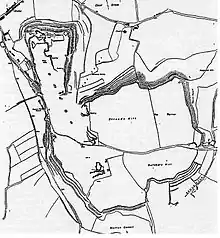 |
Ham Hill 50.9483°N 2.7416°W |
The Iron Age hill fort located on Ham Hill, called Ham Hill hill fort, is possibly the largest hill fort in Somerset. It measures 800 metres (2,600 ft) by 950 metres (3,120 ft),[116] enclosing an area of 81 hectares (200 acres).[117] Ham Hill hill fort is surrounded by banks, some of which range up to 12 metres (39 ft) high, and ditches. In addition to the Iron Age hill fort, the site was occupied during the Mesolithic Period, the Neolithic Period, and the Bronze Age. The site has also been damaged by quarrying.[116][118] |
| Highbury Hill | Iron Age | – | – | Clutton 51.3194°N 2.5243°W |
On Highbury Hill lies the earthwork remains of an Iron Age univallate hill fort. It occupies an area of woodland at the end of a narrow ridge.[119] |
| Horse Pool Camp Harbury Hamberry Whitestaunton Camp |
Iron Age | 1018636[120] | – | Whitestaunton 50.8763°N 3.0453°W |
Oval univallate hillfort 300 m long and 150 m wide.[121][122] |
| Kenwalch's Castle | Iron Age | 1008257[123] |  |
Penselwood 51.1006°N 2.3619°W |
Kenwalch's Castle is an Iron Age hill fort. The latter has an area of 1.6 hectares (4.0 acres). There is a single rampart and ditch which are well preserved in places. The road north from Penselwood village crosses the hill fort and probably passes through the original entrances.[124][125] |
| King's Castle | Iron Age | 1008807[126] | – | Wells 51.2084°N 2.6191°W |
King's Castle is the remains of an Iron Age settlement and field system.[127][128] |
| King's Castle hill fort Castle Hill hill fort |
Iron Age | 1016498[129] |  |
Wiveliscombe 51.0460°N 3.2895°W |
King's Castle hill fort is guarded by two banks and a ditch. The interior bank is from 2.5 metres (8.2 ft) to 6 metres (20 ft) high and around 14 metres (46 ft) thick. Several Neolithic artefacts have also been found on the site.[130][131] |
| Kingsdown Camp | Iron Age | 1006219[132] | – | Buckland Dinham 51.2642°N 2.4034°W |
Kingsdown Camp is a univallate hill fort with an area of .15 hectares (0.37 acres), and is approximately quadrilateral in shape. In the Iron Age or Roman period a drystone wall was constructed, possibly 4 metres (13 ft) high and 2.5 metres (8 ft) wide. There is an entrance on the northeast side. The fort continued to be used by the Romans.[133][134] |
| Maesbury Castle | Iron Age | 1015494[135] |  |
Croscombe 51.2227°N 2.5598°W |
The Maesbury Castle hill fort is a bivallate hill fort with a bank around 1.5 metres (4.9 ft) to 3 metres (9.8 ft) high enclosing an area of around 2.8 hectares (6.9 acres). A second bank around 30 centimetres (0.98 ft) high exists on the southeastern side.[136][137] |
| Maes Knoll Maes Trump |
Iron Age | 1005424[138] |  |
Norton Malreward 51.3916°N 2.5763°W |
Maes Knoll hill fort is roughly triangular, and encloses an area of 8 hectares (20 acres).[139][140] |
| Meare Lake Village | Iron Age | 1006160[141] | – | Meare 51.1760°N 2.7944°W |
Archaeologists uncovered several hearths in the buried ruins of one of the houses at the Iron Age Meare Lake Village, which was located within the now-drained Meare Pool. They also found several lias stones lying around the fire, including one vertical stone which may have been a backrest. The archaeologists also found several artefacts, including cut pieces of red deer antler, pieces of iron, the rim of a bronze bowl, a spiral finger ring made from bronze, and a decorated amber bead.[142][143][144][145] |
| Mounsey Castle | Iron Age | 1021357[146] |  |
Dulverton 51.0540°N 3.5922°W |
An irregular triangular earthwork of 1.75 hectares (4.3 acres) surrounded by the remains of coursed stone walling, with an entrance to the west.[147][148] Overlooking the River Barle.[149] |
| Norton Camp Norton Fitzwarren hill fort |
Stone Age Bronze Age |
1008467[150] | 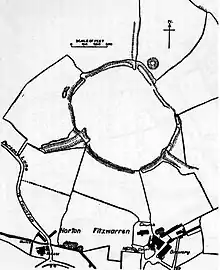 |
Norton Fitzwarren 51.0304°N 3.1479°W |
The Norton Fitzwarren hill fort is part of the "Norton Hillfort Local Nature Reserve" and originally was occupied during the Stone Age[151] and into the Bronze Age.[152][153] |
| Oldberry Castle Oldbury Castle |
Iron Age | 1006168[154] |  |
Dulverton 51.0428°N 3.5572°W |
Oldberry Castle is an irregular oval shape measuring 220 metres (720 ft) by 91 metres (299 ft). It is defended by a bank measuring 3 metres (9.8 ft) wide and 1.8 metres (5.9 ft) high, and a 5.5 metres (18 ft) wide ditch.[155][156] |
| Plainsfield Camp | Iron Age | 1007669[157] |  |
Aisholt 51.1192°N 3.1687°W |
Plainsfield Camp is a possible Iron Age univallate settlement that is shaped like a rhombus. It is around 160 metres (540 ft) by 140 metres (450 ft), enclosing an approximate area of .1 hectares (1,000 m2), with a single bank around 3.0 metres (10 ft) high.[158][159] |
| Road Castle | Iron Age | 1021360[160] | – | Winsford 51.1261°N 3.6264°W |
It is likely that the bank and ditch defined enclosure at this site is of Iron Age date.[161] |
| Roddenbury hill fort | Iron Age | 1008804[162] |  |
Selwood 51.1944°N 2.2897°W |
Roddenbury hill fort is a large, univallate hill fort enclosing .84 hectares (2.1 acres).[163][164] |
| Rodhuish Common | Iron Age | 1021122[165] | – | Withycombe 51.1435°N 3.4323°W |
On Rodhuish Common is a small oval enclosure which is thought to be of Iron Age date.[166] |
| Ruborough Camp Rowberrow Rowborough Roborough Money Field |
Iron Age | 1007670[167] |  |
Broomfield 51.0956°N 3.1038°W |
The Ruborough Camp hill fort is on an easterly spur from the main Quantock ridge, with steep natural slopes to the north and south-east. The fort is triangular in shape, with a single rampart and ditch (univallate), enclosing 1.8 hectares (4.4 acres). There is a linear outer work about 120 metres (390 ft) away, parallel to the westerly rampart, enclosing another 1.8 hectares (4.4 acres). There was a tunnel, which has now been filled in, which gave the camp safe access to a nearby spring for water.[168][169][170] |
| Sigwells | Bronze Age Iron Age |
– | – | Charlton Horethorne 51.012°N 2.507°W |
Sigwells Camp overlooks Cadbury Castle. It was the target of research by the South Cadbury Environs Project,[171] which produced significant Early Bronze Age and Middle and Late Iron Age archaeology. Of national importance was the identification of the earliest known metalworking building in Britain, dated to Middle Bronze Age (12th century BC).[172][173] |
| Small Down Knoll Small Down Camp |
Bronze Age | 1006175[174] | 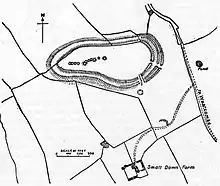 |
Evercreech 51.1646°N 2.4790°W |
Small Down Camp is a multivallate hill fort enclosing 2 hectares (4.9 acres). There is also a group of around 14 barrows within the walls of the camp. Multiple walls and a ditch defend the site, but the walls are crumbling and the ditch has been filled up.[175][176] |
| Solsbury Hill Little Solsbury Hill |
Iron Age | 1002481[177] |  |
Batheaston 51.4100°N 2.3342°W |
Occupied between 300 BC and 100 BC, comprising a triangular area enclosed by a single univallate rampart, faced inside and out with well-built dry stone walls and infilled with rubble. The rampart was 6 metres (20 ft) wide and the outer face was at least 4 metres (13 ft) high. The top of the hill was cleared down to the bedrock, then substantial huts were built with wattle and daub on a timber-frame. After a period of occupation, some of the huts were burnt down, the rampart was overthrown, and the site was abandoned, never to be reoccupied. This event is probably part of the Belgic invasion of Britain in the early part of the 1st century BC.[178] |
| Stantonbury Camp | Iron Age | 1002487[179] | Marksbury 51.3719°N 2.4718°W |
Stantonbury Camp is an Iron Age hill fort close to Wansdyke.[180] On the English Heritage Heritage at Risk Register.[181][182] | |
| Stokeleigh Camp | Iron Age | 1008113[183] | 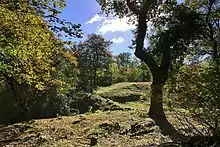 |
Leigh Woods 51.4570°N 2.6361°W |
Evidence shows that Stokeleigh Camp in Leigh Woods was a key site in the defence of the Avon Gorge.[184] It is situated on a promontory.[185] |
| Sweetworthy | Iron Age | 1008470[186] | – | Luccombe 51.1709°N 3.5891°W |
Sweetworthy is an Iron Age hill fort or enclosure on the north-facing slope of Dunkery Hill. It has a single rampart and external ditch, enclosing 0.25 hectares (0.62 acres). The rampart is still visible and the ditch on the east side is used as a trackway.[187][188] |
| Taps Combe Camp Chelvey Batch Settlement |
Iron Age | 1007909[189] | – | Chelvey 51.3996°N 2.7489°W |
Taps Combe Camp is a Roman, Iron Age univallate hill fort in Chelvey. It is "D"-shaped, and is approximately 50 metres (160 ft) by 50 metres (160 ft).[15][190][191] |
| Tedbury Camp | Iron Age | 1006163[192] | Great Elm 51.2378°N 2.3681°W |
Tedbury Camp is a multivallate promontory hill fort defended by two parallel banks. The inner bank measuring 1.3 metres (4.3 ft) wide and standing 3 metres (9.8 ft) to 4.5 metres (15 ft) high. There may have been a third bank. Also the site of Roman occupation and a coin hoard.[193][194] | |
| Trendle Ring | Iron Age | 1008249[195] |  |
Bicknoller 51.1470°N 3.2623°W |
Trendle Ring is a univallate hill fort shaped like a rounded quadrilateral, enclosing around .7 hectares (1.7 acres). It is enclosed by a ring of stones up to around 1.5 metres (4.9 ft) high and still further by a ditch.[196][197] |
| Tunley Camp | Iron Age | 1004525[198] | – | Camerton 51.3309°N 2.4561°W |
Tunley Camp comprises the slight earthwork remains of a univallate Iron Age hill fort, which is now nearly ploughed down.[199] |
| Wadbury Camp | Iron Age | 1006162[200] | – | Mells 51.2391°N 2.3803°W |
A promontory fort or univallate hillfort with earthwork remains.[201] The bank in places is up to 16 feet (4.9 m) high. Other parts have been almost completely destroyed.[202] |
| Wain's Hill | Iron Age | 1007908[203] |  |
Clevedon 51.4317°N 2.8781°W |
Wain's Hill is an Iron Age promontory bivallate hill fort visible as linear earthwork banks and ditches. It lies on a triangular spit of land on Wain's Hill in west Clevedon, and the hill fort is defined by steep natural slopes to the south, north, and west, and by two ramparts to the east.[204] |
| Walton Common banjo enclosure | Iron Age | 1007917[205] | – | Walton in Gordano 51.4597°N 2.8240°W |
A banjo enclosure believed to date from the late Iron Age.[206] |
| Westbury Camp | Iron Age | 1015500[207] | – | Rodney Stoke 51.2570°N 2.7294°W |
Westbury Camp is a large, irregularly-shaped hill fort surrounded by a bank and ditch covering approximately 2.3 hectares (5.7 acres).[208][209] |
| Worlebury Camp | Iron Age | 1011260[210] |  |
Worlebury Hill 51.3574°N 2.9852°W |
Worlebury Camp is an Iron Age hill fort that was designed for defence, as is evidenced by the number of walls and ditches around the site. Archaeologists have found several large triangular platforms around the sides of the fort, lower down on the hillside. They have found nearly one hundred storage pits of various sizes cut into the bedrock, and many of these had human remains, coins, and other artefacts in them.[211] However, in more recent times, the fort has suffered damage and been threatened with complete destruction on multiple occasions.[8][212][213] |
| Wraxall Camp | Iron Age | 1018267[214] | – | Failand 51.4444°N 2.6913°W |
This site, situated on level ground within an upland area of carboniferous limestone was an Iron Age defended settlement.[215] |
Suspected hill forts and settlements
| Site name Alternative name(s) |
Age | National Heritage List for England number | Plan | Location | Description |
|---|---|---|---|---|---|
| Berwick | Iron Age | – | – | Bath 51.3615°N 2.3742°W |
Berwick is a possible multivallate Iron Age hill fort that has since been destroyed. A "camp" called Berwick, Berewyke, or Berewyck, adjoining Cottage Crescent and near Barrack Farm, was described in the early 19th century.[216] |
| Charterhouse Camp | Neolithic Bronze Age |
1006195[217] |  |
Charterhouse 51.2986°N 2.7221°W |
There is evidence, in the form of burials in local caves, of human occupation since the late Neolithic/Early Bronze Age.[50] |
| Daw's Castle | Iron Age | 1020882[218] |  |
Watchet 51.1810°N 3.3430°W |
The Daw's Castle hill fort is situated on a north-facing cliff about 80 m above the sea, on a tapering spur of land bounded by the Washford River to the south, as it flows to the sea at Watchet, about 1 kilometre (0.62 mi) east. The ramparts of the fort would have formed a semicircle backing onto the sheer cliffs, but coastal erosion has reduced the size of the enclosure, and later destruction by farming, limekilns, and the B3191 road, have left only about 300 m of ramparts visible today.[219] The fort may be of Iron Age origin, but was (re)built and fortified as a burh by King Alfred, as part of his defense against Viking raids from the Bristol Channel around 878 AD.[220] |
References
- "Introduction to Somerset's History". Britannia. Archived from the original on 12 November 2006. Retrieved 29 October 2006.
- Fyfe, R.M.; Brown, A. G.; Rippon, S. J. (2003). "Mid- to late-Holocene vegetation history of Greater Exmoor, UK: estimating the spatial extent of human-induced vegetation change" (PDF). Vegetation History and Archaeobotany. 12 (4): 215–232. doi:10.1007/s00334-003-0018-3. S2CID 128994811.
- "The history of Exmoor". Exmoor National Park. Archived from the original on 8 March 2008. Retrieved 29 November 2007.
- Payne, Andrew; Corney, Mark; Cunliffe, Barry (2007). The Wessex Hillforts Project: Extensive Survey of Hillfort Interiors in Central Southern England. English Heritage. p. 1. ISBN 978-1-873592-85-4. Archived from the original on 11 October 2011.
- Sharples, Niall M (1991). English Heritage Book of Maiden Castle. London: B. T. Batsford. pp. 71–72. ISBN 0-7134-6083-0.
- "Time Team: Swords, skulls and strongholds". Channel 4. 19 May 2008. Archived from the original on 12 August 2011. Retrieved 16 September 2009. Cite journal requires
|journal=(help) - Alcock, Leslie (1972). Was this Camelot? Excavations at Cadbury Castle 1966-70. New York: Stein and Day. ISBN 0-8128-1505-X.
- "Desk-Based Assessment of Land Adjacent to Numbers 2-10 Upper Kewstoke Road, Weston-Super-Mare, North Somerset" (PDF). Project: PJ 195. Mercian Archaeology. Archived from the original (PDF) on 15 January 2018. Retrieved 14 January 2018.
- Cunliffe, Barry (2004). Iron Age Communities in Britain: An Account of England, Scotland and Wales from the Seventh Century BC Until the Roman Conquest. Routledge. p. 189. ISBN 978-0-415-34779-2.
- Text of the Ancient Monuments and Archaeological Areas Act 1979 as in force today (including any amendments) within the United Kingdom, from legislation.gov.uk.
- "What can be scheduled?". English Heritage. Archived from the original on 30 January 2012. Retrieved 26 April 2011.
- "Anglo-Saxon occupation site and site of Athelney Abbey on Athelney Hill". National Heritage List for England. English Heritage. Archived from the original on 2 May 2014. Retrieved 1 May 2014.
- Jackman, Brian (10 January 1998). "What's it all about, Alfred?". The Telegraph. Archived from the original on 26 February 2016. Retrieved 29 March 2011.
- "Backwell Hillfort". Pastscape National Monuments Record. English Heritage. Archived from the original on 30 September 2012. Retrieved 16 March 2011.
- Russet, Vince, ed. (2007). "Four Enclosures on Broadfield Down, North Somerset" (PDF). Yatton, Congresbury, Claverham, and Cleeve Archaeological Research Team. YCCCART: 4. Retrieved 21 September 2017.
- "Banwell Camp: a large multivallate hillfort on Banwell Plain". National Heritage List for England. English Heritage. Archived from the original on 20 June 2014. Retrieved 1 May 2014.
- "Banwell Camp". Pastscape National Monuments Record. English Heritage. Archived from the original on 1 October 2012. Retrieved 16 March 2011.
- "Mendip Hills". English Heritage. Archived from the original on 1 April 2011. Retrieved 15 January 2011.
- "Slight univallate hillfort called Bathampton Camp". National Heritage List for England. English Heritage. Archived from the original on 2 May 2014. Retrieved 1 May 2014.
- "Bathampton Camp". Pastscape National Monuments Record. English Heritage. Archived from the original on 4 May 2015. Retrieved 14 May 2011.
- "Bat's Castle: a small multivallate hillfort and associated outwork". National Heritage List for England. English Heritage. Archived from the original on 20 June 2014. Retrieved 1 May 2014.
- "Bat's Castle, Gallox Hill, Carhampton". Exmoor Historic Environment Record. English Heritage. Archived from the original on 27 September 2012. Retrieved 16 March 2011.
- Bush, Robin (1994). Somerset: The complete guide. Wimborne, Dorset: Dovecote Press. p. 55. ISBN 978-1-874336-26-6.
- "Bats Castle". Pastscape National Monuments Record. English Heritage. Archived from the original on 2 October 2012. Retrieved 16 March 2011.
- "Berry Castle, Iron Age enclosure in Berry Castle Wood". National Heritage List for England. English Heritage. Archived from the original on 2 May 2014. Retrieved 1 May 2014.
- "Berry Castle". Pastscape National Monuments Record. English Heritage. Archived from the original on 3 October 2012. Retrieved 14 May 2011.
- "Berry Castle". Exmoor National Park Historic Environment Record. English Heritage. Archived from the original on 1 October 2012. Retrieved 14 May 2011.
- "Black Ball Camp: a later prehistoric defended settlement on Gallox Hill". National Heritage List for England. English Heritage. Archived from the original on 20 June 2014. Retrieved 1 May 2014.
- "Black Ball Camp". Exmoor Historic Environment Record. English Heritage. Archived from the original on 28 September 2012. Retrieved 21 March 2011.
- "Black Ball Camp". Somerset Historic Environment Record. Somerset County Council. Archived from the original on 3 October 2016. Retrieved 15 November 2010.
- "Small multivallate promontory fort on Blacker's Hill". National Heritage List for England. English Heritage. Archived from the original on 20 June 2014. Retrieved 1 May 2014.
- "Iron age promontory fort, Blackers Hill, Chilcompton". Somerset Historic Environment Record. Somerset County Council. Archived from the original on 3 October 2016. Retrieved 20 November 2010.
- "Blackers Hill". Pastscape National Monuments Record. English Heritage. Archived from the original on 2 October 2012. Retrieved 21 March 2011.
- "Multi-period site on Brean Down". National Heritage List for England. English Heritage. Archived from the original on 2 May 2014. Retrieved 1 May 2014.
- "Hillfort, Brean Down". Somerset Historic Environment Record. Somerset County Council. Archived from the original on 3 October 2016. Retrieved 15 January 2011.
- "Brean Down". Conservation, Heritage, & Learning. National Trust. Archived from the original on 2 February 2011. Retrieved 15 January 2011.
- "Hillfort, Brean Down". Somerset Historic Environment Record. Somerset County Council. Archived from the original on 3 October 2016. Retrieved 21 March 2011.
- "Brean Down". Pastscape National Monuments Record. English Heritage. Archived from the original on 2 October 2012. Retrieved 21 March 2011.
- "Brent Knoll hillfort and associated field system". National Heritage List for England. English Heritage. Archived from the original on 2 May 2014. Retrieved 1 May 2014.
- "Brent Knoll hillfort, Brent Knoll". Somerset Historic Environment Record. Somerset County Council. Archived from the original on 3 October 2016. Retrieved 30 December 2010.
- "Brent Knoll Camp". Pastscape National Monuments Record. English Heritage. Archived from the original on 2 October 2012. Retrieved 21 March 2011.
- "Brewer's Castle". National Heritage List for England. English Heritage. Archived from the original on 2 May 2014. Retrieved 1 May 2014.
- "Brewer's Castle". Pastscape National Monuments Record. English Heritage. Archived from the original on 3 October 2012. Retrieved 21 March 2011.
- "Broomfield Camp". Pastscape National Monuments Record. English Heritage. Archived from the original on 3 October 2012. Retrieved 14 May 2011.
- "Higher Castles enclosure, Broomfield". Somerset Historic Environment Record. Somerset County Council. Archived from the original on 3 October 2016. Retrieved 14 May 2011.
- "Burgh Walls Camp". Pastscape National Monuments Record. English Heritage. Archived from the original on 2 October 2012. Retrieved 6 March 2011.
- "Large univallate hillfort with outworks 800m west of White Cross". National Heritage List for England. English Heritage. Archived from the original on 2 May 2014. Retrieved 1 May 2014.
- "Burledge Hillfort". Pastscape National Monuments Record. English Heritage. Archived from the original on 30 September 2012. Retrieved 16 March 2011.
- "Slight univallate hillfort and associated earthworks on Burrington Ham". National Heritage List for England. English Heritage. Archived from the original on 2 May 2014. Retrieved 1 May 2014.
- "Mendip Hills An Archaeological Survey of the Area of Outstanding Natural Beauty" (PDF). Somerset County Council Archaeological Projects. Somerset County Council. Archived (PDF) from the original on 16 May 2011. Retrieved 16 January 2011.
- "Burrington Camp". Pastscape National Monuments Record. English Heritage. Archived from the original on 1 October 2012. Retrieved 16 March 2011.
- "Bury Castle, an Iron Age defended settlement". National Heritage List for England. English Heritage. Archived from the original on 2 May 2014. Retrieved 1 May 2014.
- "Bury Castle". Pastscape National Monuments Record. English Heritage. Archived from the original on 25 February 2012. Retrieved 21 March 2011.
- "Bury Castle". Exmoor Historic Environment Record. English Heritage. Archived from the original on 24 September 2012. Retrieved 16 January 2011.
- "Cadbury Camp, a small multivalate hillfort on Cadbury Hill". National Heritage List for England. English Heritage. Archived from the original on 2 May 2014. Retrieved 1 May 2014.
- "Cadbury Camp". Pastscape National Monuments Record. English Heritage. Archived from the original on 1 June 2015. Retrieved 16 March 2011.
- Phelps, W. The History and Antiquities of Somersetshire; Being a General and Parochial Survey of That Interesting County, to which is Prefixed an Historical Introduction, with a Brief View of Ecclesiastical History; and an Account of the Druidical, Belgic-British, Roman, Saxon, Danish, and Norman Antiquities, Now Extant, Vol. II, Ch. VI, §1: "Camalet or Cadbury", p. 118 Archived 2 May 2016 at the Wayback Machine. J. B. Nichols & Son (London), 1839.
- "Large multivallate hillfort and associated earthworks at South Cadbury". National Heritage List for England. English Heritage. Archived from the original on 20 June 2014. Retrieved 1 May 2014.
- "Cadbury Castle, South Cadbury". Somerset Historic Environment record. Somerset County Council. Archived from the original on 3 October 2016. Retrieved 28 December 2010.
- Hill, J. D. & Moorhead, T. S. N. (15 October 2010). "Iron Age Sites in Britain". British Broadcasting Corporation. Archived from the original on 4 October 2010. Retrieved 26 December 2010.
- "Large univallate hillfort on Cadbury Hill". National Heritage List for England. English Heritage. Archived from the original on 2 May 2014. Retrieved 1 May 2014.
- Alcock, Leslie (1971). Arthur's Britain. London: Allen Lane: The Penguin Press. ISBN 978-0-7139-0245-7.
- "Cadbury Hill Camp". Pastscape National Monuments Record. English Heritage. Archived from the original on 1 October 2012. Retrieved 16 March 2011.
- "Excavation (2008-9), Cambria Farm, Taunton". Somerset Historic Environment Record. English Heritage. Archived from the original on 24 September 2012. Retrieved 16 January 2011.
- "Monument No. 190630". National Monument Record. English Heritage. Archived from the original on 2 October 2012. Retrieved 22 March 2011.
- "Cynwit Castle". National Heritage List for England. English Heritage. Archived from the original on 2 May 2014. Retrieved 1 May 2014.
- "Cynwit Castle (Cannington Camp), Cannington Park, Cannington". Somerset Historic Environment Record. Somerset County Council. Archived from the original on 3 October 2016. Retrieved 29 December 2010.
- "Cannington Park Camp". Pastscape National Monuments Record. English Heritage. Archived from the original on 1 October 2012. Retrieved 16 March 2011.
- "Castle Neroche: a motte and bailey castle and earlier defences above Castle Plantation". National Heritage List for England. English Heritage. Retrieved 20 November 2018.
- "Castle Neroche, Curland". Somerset Historic Environment Record. Somerset County Council. Archived from the original on 3 October 2016. Retrieved 26 December 2010.
- "Castle Neroche". National Monument Record. English Heritage. Archived from the original on 30 September 2012. Retrieved 22 March 2011.
- "The Castles". National Heritage List for England. English Heritage. Archived from the original on 20 June 2014. Retrieved 1 May 2014.
- "Details, Somerset EHR". EHR. Archived from the original on 3 October 2016. Retrieved 7 July 2011.
- "The Castles". Pastscape National Monuments Record. English Heritage. Archived from the original on 8 October 2012. Retrieved 7 July 2011.
- "Clatworthy hillfort". National Heritage List for England. English Heritage. Archived from the original on 2 May 2014. Retrieved 1 May 2014.
- "Clatworthy Camp, Clatworthy". Somerset Historic Environment Record. Somerset County Council. Archived from the original on 3 October 2016. Retrieved 15 January 2011.
- "Clatworthy Camp". Pastscape National Monuments Record. English Heritage. Archived from the original on 1 October 2012. Retrieved 16 March 2011.
- "Slight univallate hillfort 150m east of Cleeve Court". National Heritage List for England. English Heritage. Archived from the original on 2 May 2014. Retrieved 1 May 2014.
- "Cleeve Toot Camp". Pastscape National Monuments Record. English Heritage. Archived from the original on 2 October 2012. Retrieved 17 March 2011.
- "Slight univallate hillfort on Conygar Hill". National Heritage List for England. English Heritage. Archived from the original on 20 June 2014. Retrieved 1 May 2014.
- "Conygar". Pastscape National Monuments Record. English Heritage. Archived from the original on 2 October 2012. Retrieved 6 March 2011.
- "Cow Castle". National Heritage List for England. English Heritage. Archived from the original on 20 June 2014. Retrieved 1 May 2014.
- "Cow Castle". Exmoor Historic Environment Record. English Heritage. Archived from the original on 24 September 2012. Retrieved 16 January 2011.
- "Cow Castlde". Pastscape National Monuments Record. English Heritage. Archived from the original on 2 October 2012. Retrieved 22 March 2011.
- "Later prehistoric defended enclosure, Long Wood". National Heritage List for England. English Heritage. Archived from the original on 2 May 2014. Retrieved 1 May 2014.
- "Later prehistoric defended enclosure, Long Wood". National Heritage List for England. English Heritage. Archived from the original on 13 January 2015. Retrieved 1 December 2014.
- "MSO9087 - Long Wood Enclosure". Exmoor National Park Historic Environment Record. Exmoor National Park. Archived from the original on 29 December 2014. Retrieved 1 December 2014.
- "Longwood". Pastscape. English Heritage. Archived from the original on 29 December 2014. Retrieved 1 December 2014.
- "Curdon Wood camp". National Heritage List for England. English Heritage. Archived from the original on 20 June 2014. Retrieved 1 May 2014.
- "Curdon Wood Camp". Somerset Historic Environment Record. Somerset County Council. Archived from the original on 3 October 2016. Retrieved 28 December 2010.
- "Curdon Camp". Pastscape National Monuments Record. English Heritage. Archived from the original on 2 October 2012. Retrieved 16 March 2011.
- "Archaeological Aerial Survey in the Northern Mendip Hills" (PDF). English Heritage. p. 34. Archived (PDF) from the original on 4 February 2014. Retrieved 23 March 2011.
- "Dinghurst Camp". Pastscape National Monuments Record. English Heritage. Archived from the original on 1 October 2012. Retrieved 16 March 2011.
- "Dolebury Camp: a large univallate hillfort and associated and later earthworks on Dolebury Warren". National Heritage List for England. English Heritage. Archived from the original on 20 June 2014. Retrieved 1 May 2014.
- Scarth, M. A. (December 1885). Proceedings of the Bath Natural History and Antiquarian Field Club (ebook). Proceedings of the Bath Natural History and Antiquarian Field Club. 5. Bath, Somerset: Bath Natural History and Antiquarian Field Club. Retrieved 3 January 2011.
- "Dolebury Camp". Pastscape National Monuments Record. English Heritage. Archived from the original on 1 October 2012. Retrieved 16 March 2011.
- "Dowsborough hillfort and associated round barrow". National Heritage List for England. English Heritage. Archived from the original on 2 May 2014. Retrieved 1 May 2014.
- "Dowsborough hillfort, Holford". Somerset Historic Environment Record. Somerset County Council. Archived from the original on 3 October 2016. Retrieved 28 December 2010.
- "Compton Dundon hillfort with Dundon Beacon, east of Dundon". National Heritage List for England. English Heritage. Archived from the original on 20 June 2014. Retrieved 1 May 2014.
- "Dundon Hillfort, Compton Dundon". Somerset Historic Environment Record. Somerset County Council. Archived from the original on 3 October 2016. Retrieved 27 December 2010.
- "Dundon Hill". Pastscape National Monuments Record. English Heritage. Archived from the original on 25 March 2012. Retrieved 23 March 2011.
- "Elborough Hill". Pastscape National Monuments Record. English Heritage. Archived from the original on 2 October 2012. Retrieved 6 March 2011.
- "Elworthy Barrows hillfort". National Heritage List for England. English Heritage. Retrieved 1 May 2014.
- "Elworthy Barrows hillfort". Somerset Historic Environment Record. Somerset County Council. Archived from the original on 3 October 2016. Retrieved 28 December 2010.
- "Elworthy Barrows Hillfort". Pastscape National Monuments Record. English Heritage. Archived from the original on 25 March 2012. Retrieved 23 March 2011.
- "Glastonbury lake village". National Heritage List for England. English Heritage. Archived from the original on 2 May 2014. Retrieved 1 May 2014.
- Koch, John T. (2006). Celtic Culture: A Historical Encyclopedia. ABC-CLIO Ltd. p. 1084. ISBN 978-1851094400. Archived from the original on 3 May 2016.
- "Glastonbury Lake Village". Pastscape National Monuments Record. English Heritage. Archived from the original on 2 October 2012. Retrieved 16 March 2011.
- "St Michael's Church, monastic remains, and other settlement remains on Glastonbury Tor". National Heritage List for England. English Heritage. Archived from the original on 29 October 2013. Retrieved 1 May 2014.
- "Prehistoric, Roman and Post-Roman occupation, Glastonbury Tor". Somerset Historic Environment Record. Somerset County Council. Archived from the original on 3 October 2016. Retrieved 28 December 2010.
- "Earthworks Glastonbury Tor". Pastscape National Monuments Record. English Heritage. Archived from the original on 2 October 2012. Retrieved 23 March 2011.
- "Hillfort on Grabbist Hill, 275m south west of St Leonard's Well". National Heritage List for England. English Heritage. Archived from the original on 2 May 2014. Retrieved 1 May 2014.
- "Grabbist Hillfort". Exmoor Historic Environment Record. English Heritage. Archived from the original on 28 September 2012. Retrieved 23 March 2011.
- "Monument No. 36851". Pastscape National Monuments Record. English Heritage. Archived from the original on 2 October 2012. Retrieved 23 March 2011.
- "Hamdon Hill camp". National Heritage List for England. English Heritage. Archived from the original on 2 May 2014. Retrieved 1 May 2014.
- "Hamdon Hill Camp". Somerset Historic Environment Record. Somerset County Council. Archived from the original on 3 October 2016. Retrieved 26 December 2010.
- "Ham Hill". Roman-Britain. Archived from the original on 13 June 2010. Retrieved 26 December 2010.
- "Monument No. 1043362". National Monuments Record. English Heritage. Archived from the original on 2 October 2012. Retrieved 17 March 2011.
- "Highbury Hill". Pastscape National Monuments Record. English Heritage. Archived from the original on 2 October 2012. Retrieved 6 March 2011.
- "Hillfort 475m south of Howley Farm". National Heritage List for England. English Heritage. Archived from the original on 20 June 2014. Retrieved 1 May 2014.
- "Horse Pool Camp". Somerset Historic Environment Record. Somerset County Council. Archived from the original on 3 October 2016. Retrieved 26 August 2011.
- "Whitestaunton Camp". Pastscape National Monuments Record. English Heritage. Archived from the original on 2 May 2014. Retrieved 5 October 2012.
- "Kenwalch's Castle: a large univallate hillfort on Pen Hill". National Heritage List for England. English Heritage. Retrieved 1 May 2014.
- "Kenwalch's Castle hillfort, Pen Wood, Charlton Musgrove". Somerset Historic Environment Record. Somerset County Council. Archived from the original on 3 October 2016. Retrieved 15 January 2011.
- "Kenwalch's Castle". Pastscape National Monuments Record. English Heritage. Archived from the original on 2 October 2012. Retrieved 24 March 2011.
- "King's Castle enclosures, Iron Age defended settlement". National Heritage List for England. English Heritage. Archived from the original on 2 May 2014. Retrieved 1 May 2014.
- "King's Castle". Somerset Historic Environment Record. Somerset County Council. Archived from the original on 3 October 2016. Retrieved 14 May 2011.
- "Kings Castle". Pastscape National Monuments Record. English Heritage. Archived from the original on 29 April 2014. Retrieved 28 April 2014.
- "Hillfort on Castle Hill 650m south east of Ford House". National Heritage List for England. English Heritage. Archived from the original on 20 June 2014. Retrieved 1 May 2014.
- "Hillfort, King's Castle, Wiveliscombe". Somerset Historic Environment Record. Somerset County Council. Archived from the original on 3 October 2016. Retrieved 27 December 2010.
- "Kings Castle". Pastscape National Monuments Record. English Heritage. Archived from the original on 2 October 2012. Retrieved 17 March 2011.
- "Kingsdown camp, Mells Down". National Heritage List for England. English Heritage. Archived from the original on 2 May 2014. Retrieved 1 May 2014.
- "Kingsdown Camp, Mells Down, Mells". Somerset Historic Environment Record. Somerset County Council. Archived from the original on 3 October 2016. Retrieved 15 January 2011.
- "Kingsdown Camp". Pastscape National Monuments Record. English Heritage. Archived from the original on 2 October 2012. Retrieved 17 March 2011.
- "Maesbury Castle small multivallate hillfort". National Heritage List for England. English Heritage. Archived from the original on 20 June 2014. Retrieved 1 May 2014.
- "Maesbury Castle Hillfort, Croscombe". Somerset Historic Environment Record. Somerset County Council. Archived from the original on 3 October 2016. Retrieved 30 December 2010.
- "Measbury Castle". Pastscape National Monuments Record. English Heritage. Archived from the original on 2 October 2012. Retrieved 24 March 2011.
- "Maes Knoll camp". National Heritage List for England. English Heritage. Archived from the original on 2 May 2014. Retrieved 1 May 2014.
- "Section 1:Maes Knoll — Somerset". West Wansdyke 1. Wansdyke Project 21. Archived from the original on 15 May 2011. Retrieved 8 January 2011.
- "Maes Knoll". Pastscape National Monuments Record. English Heritage. Archived from the original on 1 October 2012. Retrieved 16 March 2011.
- "Lake villages NW of Oxenpill". National Heritage List for England. English Heritage. Archived from the original on 2 May 2014. Retrieved 1 May 2014.
- "Meare Lake Village, Somerset". Nature. 142 (3593): 468. 10 September 1938. Bibcode:1938Natur.142R.468.. doi:10.1038/142468b0. S2CID 4123965.
- "Iron-age settlement (Meare West), Meare". Somerset Historic Environment Record. Somerset County Council. Archived from the original on 3 October 2016. Retrieved 10 February 2011.
- "Iron-age settlement (Meare East), Meare". Somerset Historic Environment Record. Somerset County Council. Archived from the original on 3 October 2016. Retrieved 10 February 2011.
- "The Meare Lake Villages". Pastscape National Monuments Record. English Heritage. Archived from the original on 30 September 2012. Retrieved 16 March 2011.
- "Mounsey Castle and an associated outwork 100m to the north". National Heritage List for England. English Heritage. Archived from the original on 2 May 2014. Retrieved 1 May 2014.
- "Mounsey Castle". Exmoor Historic Environment Record. English Heritage. Archived from the original on 24 September 2012. Retrieved 16 January 2011.
- "Mounsey Castle and associated outwork 100 m to the north". Somerset Historic Environment Record. Somerset County Council. Archived from the original on 3 October 2016. Retrieved 28 February 2011.
- "Mounsey Castle". National Monuments Record. English Heritage. Archived from the original on 2 October 2012. Retrieved 24 March 2011.
- "Norton Camp large univallate hillfort". National Heritage List for England. English Heritage. Archived from the original on 20 June 2014. Retrieved 1 May 2014.
- "Norton Hillfort". Services Directory. Taunton Deane Borough Council. Archived from the original on 17 July 2011. Retrieved 27 December 2010.
- "Norton Camp hillfort, Norton Fitzwarren". Somerset Historic Environment Record. Somerset County Council. Archived from the original on 3 October 2016. Retrieved 27 December 2010.
- "Norton Camp". Pastscape National Monuments Record. English Heritage. Archived from the original on 2 October 2012. Retrieved 26 March 2011.
- "Oldberry Castle". National Heritage List for England. English Heritage. Archived from the original on 2 May 2014. Retrieved 1 May 2014.
- "Oldbury (or Oldberry) Castle, NW of Dulverton". Exmoor Historic Environment Record. English Heritage. Archived from the original on 24 September 2012. Retrieved 16 January 2011.
- "Oldberry Castle". Pastscape National Monuments Record. English Heritage. Archived from the original on 2 October 2012. Retrieved 17 March 2011.
- "Plainsfield Camp slight univallate hillfort". National Heritage List for England. English Heritage. Archived from the original on 2 May 2014. Retrieved 1 May 2014.
- "Plainsfield Camp, Park Plantation, Over Stowey". Somerset Historic Environment Record. Somerset County Council. Archived from the original on 3 October 2016. Retrieved 15 January 2011.
- "Plainsfield Camp". Pastscape National Monuments Record. English Heritage. Archived from the original on 2 October 2012. Retrieved 26 March 2011.
- "Road Castle". National Heritage List for England. English Heritage. Archived from the original on 20 June 2014. Retrieved 1 May 2014.
- "Road Castle". Pastscape National Monuments Record. English Heritage. Archived from the original on 3 October 2012. Retrieved 26 March 2011.
- "Hillfort on Roddenbury Hill". National Heritage List for England. English Heritage. Archived from the original on 2 May 2014. Retrieved 1 May 2014.
- "Roddenbury Hillfort, Longleat Wood, Selwood". Somerset Historic Environment Record. Somerset County Council. Archived from the original on 3 October 2016. Retrieved 15 January 2011.
- "Roddenbury Camp". Pastscape National Monuments Record. English Heritage. Archived from the original on 2 October 2012. Retrieved 26 March 2011.
- "Earthwork enclosure on Rodhuish Common, 300m west of Moor Barn". National Heritage List for England. English Heritage. Archived from the original on 8 December 2014. Retrieved 1 May 2014.
- "Rodhuish Common". Pastscape National Monuments Record. English Heritage. Archived from the original on 3 October 2012. Retrieved 26 March 2011.
- "Ruborough Camp large univallate hillfort". National Heritage List for England. English Heritage. Archived from the original on 20 June 2014. Retrieved 1 May 2014.
- Waite, Vincent (1964). Portrait of the Quantocks. London: Robert Hale. ISBN 978-0-7091-1158-0.
- "Ruborough Camp". Somerset Historic Environment Record. Somerset County Council. Archived from the original on 3 October 2016. Retrieved 15 January 2011.
- "Ruborough Camp". Pastscape National Monuments Record. English Heritage. Archived from the original on 2 October 2012. Retrieved 26 March 2011.
- "South Cadbury Environs Project". South Cadbury Environs Project. Archived from the original on 17 March 2012. Retrieved 11 February 2011.
- Tabor, Richard (2008). Cadbury Castle: The hillfort and landscapes. Stroud: The History Press. pp. 61–69. ISBN 978-0-7524-4715-5.
- "Sigwells Camp". Pastscape National Monuments Record. English Heritage. Archived from the original on 30 September 2012. Retrieved 16 March 2011.
- "Small Down Knoll camp". National Heritage List for England. English Heritage. Archived from the original on 2 May 2014. Retrieved 1 May 2014.
- "Small Down Camp, Evercreech". Somerset Historic Environment Record. Somerset County Council. Archived from the original on 3 October 2016. Retrieved 29 December 2010.
- "Small Down Camp". Pastscape National Monuments Record. English Heritage. Archived from the original on 2 October 2012. Retrieved 17 March 2011.
- "Slight univallate hillfort 190m north west of Westleigh". National Heritage List for England. English Heritage. Archived from the original on 2 May 2014. Retrieved 1 May 2014.
- "Solsbury Hill". Pastscape National Monuments Record. English Heritage. Archived from the original on 1 October 2012. Retrieved 16 March 2011.
- "Stantonbury camp and adjacent sections of Wansdyke". National Heritage List for England. English Heritage. Archived from the original on 2 May 2014. Retrieved 1 May 2014.
- "Stantonbury Hill". Wansdyke Project 21. Archived from the original on 15 May 2011. Retrieved 27 March 2011.
- "Stantonbury Camp". Heritage at Risk. English Heritage. Archived from the original on 6 October 2017. Retrieved 6 October 2017.
- "Stantonbury Camp". Pastscape National Monuments Record. English Heritage. Archived from the original on 1 October 2012. Retrieved 16 March 2011.
- "Stokeleigh Camp: a promontory fort in Leigh Woods". National Heritage List for England. English Heritage. Archived from the original on 20 June 2014. Retrieved 1 May 2014.
- "Where I Live: Bristol". British Broadcasting Corporation. October 2004. Archived from the original on 20 April 2011. Retrieved 26 December 2010.
- "Stokeleigh Camp". Pastscape National Monuments Record. English Heritage. Archived from the original on 30 September 2012. Retrieved 16 March 2011.
- "Sweetworthy Iron Age defended settlement". National Heritage List for England. English Heritage. Archived from the original on 20 June 2014. Retrieved 1 May 2014.
- "Sweetworthy". Exmoor Environment Record. English Heritage. Archived from the original on 24 September 2012. Retrieved 16 January 2011.
- "Sweetworthy". Pastscape National Monuments Record. English Heritage. Archived from the original on 1 October 2012. Retrieved 16 March 2011.
- "Slight univallate hillfort 115m east of Brockley Cottage". National Heritage List for England. English Heritage. Archived from the original on 2 May 2014. Retrieved 1 May 2014.
- "Taps Combe Camp". Pastscape National Monuments Record. English Heritage. Archived from the original on 2 October 2012. Retrieved 17 March 2011.
- Everden, Shirley (August 2009). "Enclosure at Chelvey Batch, Broadfield Down Earthwork Survey" (PDF). Retrieved 21 September 2017.
- "Tedbury camp". National Heritage List for England. English Heritage. Archived from the original on 20 June 2014. Retrieved 1 May 2014.
- "Tedbury Camp, Elm". Somerset Historic Environment Record. Somerset County Council. Archived from the original on 3 October 2016. Retrieved 15 January 2011.
- "Tedbury Camp". Pastscape National Monuments Record. English Heritage. Archived from the original on 1 October 2012. Retrieved 16 March 2011.
- "Trendle Ring hillfort and associated outwork". National Heritage List for England. English Heritage. Archived from the original on 2 May 2014. Retrieved 1 May 2014.
- "Trendle Ring hillfort, Bicknoller Hill, Bicknoller". Somerset Historic Environment Record. Somerset County Council. Archived from the original on 3 October 2016. Retrieved 25 December 2010.
- "Trendle Ring". Pastscape National Monuments Record. English Heritage. Archived from the original on 2 October 2012. Retrieved 26 March 2011.
- "Slight univallate hillfort 125m west of Tunley Farm". National Heritage List for England. English Heritage. Archived from the original on 2 May 2014. Retrieved 1 May 2014.
- "Tunley Camp". Pastscape National Monuments Record. English Heritage. Archived from the original on 2 October 2012. Retrieved 6 March 2011.
- "Wadbury camp". National Heritage List for England. English Heritage. Retrieved 1 May 2014.
- "Wadbury Camp". Pastscape National Monuments Record. English Heritage. Archived from the original on 3 October 2012. Retrieved 14 May 2011.
- "Wadbury Hillfort, Wadbury". Somerset Historic Environment Record. Somerset County Council. Archived from the original on 3 October 2016. Retrieved 14 May 2011.
- "Slight univallate hillfort at Wain's Hill". National Heritage List for England. English Heritage. Archived from the original on 2 May 2014. Retrieved 1 May 2014.
- "Wain's Hill fort". Pastscape National Monuments Record. English Heritage. Archived from the original on 2 October 2012. Retrieved 6 March 2011.
- "Slight univallate hillfort, two avenues, saucer barrow, regular aggregate field system and associated earthworks on Walton Common". National Heritage List for England. English Heritage. Archived from the original on 13 January 2015. Retrieved 1 May 2014.
- "Walton Banjo". Pastscape National Monuments Record. English Heritage. Archived from the original on 3 October 2012. Retrieved 14 May 2011.
- "Westbury Camp, slight univallate hillfort, 750m north of Stokewood Cottage". National Heritage List for England. English Heritage. Archived from the original on 20 June 2014. Retrieved 1 May 2014.
- "Westbury Camp hillfort, N of Stoke Woods, Rodney Stoke". Somerset Historic Environment Record. Somerset County Council A. Archived from the original on 3 October 2016. Retrieved 16 January 2011.
- "Westbury Camp". Pastscape National Monuments Record. English Heritage. Archived from the original on 2 October 2012. Retrieved 26 March 2011.
- "Worlebury Camp: a large multivallate hillfort on Worlebury Hill". National Heritage List for England. English Heritage. Retrieved 1 May 2014.
- "Worlebury Camp". Roman-Britain.org. Archived from the original on 13 June 2010. Retrieved 5 October 2010.
- "Advice on Potential Landscape/Seascape and Visual Impacts of a Severn Barrage" (PDF). Land Use Consultants. Archived from the original (PDF) on 27 March 2012. Retrieved 29 October 2010.
- "Worlebury Camp". Pastscape National Monuments Record. English Heritage. Archived from the original on 1 October 2012. Retrieved 16 March 2011.
- "Iron Age defended settlement 400m south of Manor Farm". National Heritage List for England. English Heritage. Archived from the original on 2 May 2014. Retrieved 1 May 2014.
- "Wraxall Camp". Pastscape National Monuments Record. English Heritage. Archived from the original on 3 October 2012. Retrieved 14 May 2011.
- "Berwick". Pastscape National Monuments Record. English Heritage. Archived from the original on 2 October 2012. Retrieved 6 March 2011.
- "Camp 600yds (548m) E of Charterhouse". National Heritage List for England. English Heritage. Archived from the original on 2 May 2014. Retrieved 1 May 2014.
- "Daw's Castle". National Heritage List for England. English Heritage. Archived from the original on 20 June 2014. Retrieved 1 May 2014.
- "Daws Castle, Watchet". Somerset Historic Environment Record. Somerset County Council. Archived from the original on 3 October 2016. Retrieved 14 January 2011.
- "Daws Castle". Pastscape National Monuments Record. English Heritage. Archived from the original on 2 October 2012. Retrieved 16 March 2011.